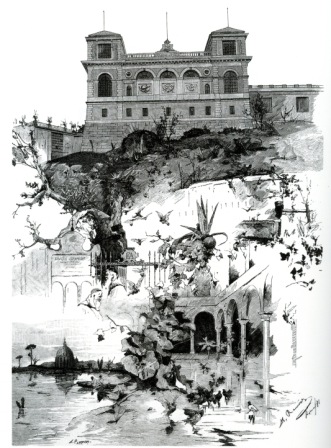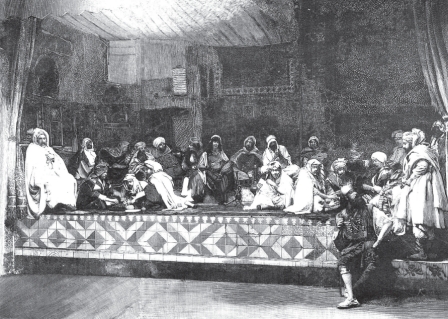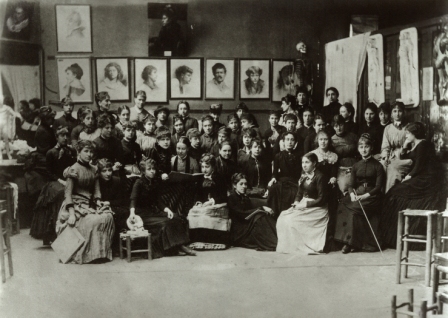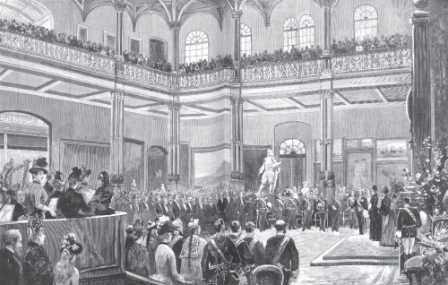November 24
lecture series
training AND sponsorship IN CONTEMPORARY ARTISTS
From the Academy to the café: spaces for meetingand artistic promotion in the 19th century
Mr. José Javier Azanza López
Chairof Navarrese Heritage and Art
In the field of artistic trainingin the 19th century, it is obligatory to pass through one of the national teachingcentres, the most important of which was the Royal Academy of Fine Arts of San Fernando, access to which was conditional on a double requirement: the presentationof a certificateproving that the applicant had received trainingat school and passing an entrance exam. After successive regulations, the Royal Decree of 25 September 1844 regulated the Study programof painting, sculpture, engraving and architecture, all of which were free, except for architecture. The aim of the students' goalwas threefold: to achieve prestige by enrolling at the main centre of artistic trainingin the country; to receive knowledge with which to dedicate themselves professionally to the specialization programstudied; and to achieve the degree scrollof teacher to teach teachingin official and private centres.
Once they had completed their training in Madrid, in many cases the students returned to their places of origin, where they dedicated themselves to teaching. trainingHowever, there were others who decided to continue their studies abroad, a decision generally endorsed by the committeeof a prestigious artist.
Travelling abroad was one of the episodes core topicin the trainingof Spanish artists in the 19th century, through a system of grants and pensions that made it possible to cover the costs of travel and accommodation. Whether in Rome or Paris, apprenticeship had two essential facets: attendanceat a centre of training, and copying the great masters of the local art galleries.
Rome was the traditional academic pathway, to the extent that in the second half of the 19th century Spanish painters achieved a position never attained by any other groupof artists; the copying of works by masters of the past and the international successes of Eduardo Rosales and Mariano Fortuny, established in the Eternal City from 1857 and 1858 respectively, are other reasons for the Spanish presence in Rome. The establishment of the Spanish Academy in 1873 (inaugurated in 1881) in the church of San Pietro in Montorio confirmed the city's role as a training destination for a large number of Spanish artists. Other centres of learning frequented by the Spanish artistic colony were the San Luca Academy, the French Academy, the Chigi Academy, and the International Art Centre, famous for its carnival parties, in whose decoration the artists collaborated by decorating the premises with scenery in keeping with their national origin.

Manuel Ramírez. Spanish Academy of Fine Arts in Rome
La Ilustración Española y Americana (8-II-1881)
Although Rome continued to be the destination of many artists throughout the 19th century, from the middle of the century Paris became increasingly important in the artistic field. This was a Europe-wide phenomenon, to which the process of artistic and urban renewal undergone by the French capital contributed, giving it a cosmopolitan image that fascinated a multitude of young people. In the specific case of Spain, the support of official institutions, the influence exerted on official artistic circles by the landscape painter Carlos de Haes, who encouraged his pupils to travel to Paris, and the growing interest of Parisian clients in Spanish themes were other reasons why many artists came to Paris.

Arab coffee represented by Spanish artists at the International Artistic Circle in Rome
La Ilustración Española y Americana (22-III-1892)
Although Rome continued to be the destination of many artists throughout the 19th century, from the middle of the century Paris became increasingly important in the artistic field. This was a Europe-wide phenomenon, to which the process of artistic and urban renewal undergone by the French capital contributed, giving it a cosmopolitan image that fascinated a multitude of young people. In the specific case of Spain, the support of official institutions, the influence exerted on official art circles by the landscape painter Carlos de Haes, who encouraged his pupils to travel to Paris, and the growing interest of Parisian clients in Spanish themes were other reasons why many artists came to Paris.
Spanish artists generally tended towards an academic style training, and the École des Beaux-Arts was the centre of programs of studyfor anyone wishing to build up a curriculum. In order to be admitted, students had to be under thirty years of age and carry a cover letterfrom a recognised master certifying the pupil's ability. There were times when a previous period of trainingin the atelier of a great master was also required. Those of Léon Cogniet, Léon Bonnat, Thomas Couture and Charles Gleyre were among the most prestigious and frequented by Spanish artists.
Parallel to the phenomenon of the ateliers, academies also appeared in Paris, free teachingcentres where teachingmasters of one kind or another gave classes specialization program; some achieved great prestige, such as the Académie Julian and the Académie Colarossi, with gradecommon to both being Admissions Officefor female students, who at that time were barred from programs of studyin the schools of fine arts. The Parisian cafés also became a favourable setting for the emergence of new trends in the midst of passionate debates; These included the cafés Fleurus, La Rochefoucauld, Guerbois (which witnessed the first steps of Impressionism), La Nouvelle Athènes, La Côte d'Or, the Café du Tambourin and the Café Versailles, all of which were followed in the early 20th century by Le Lapin Agile, where artists and writers such as Picasso, Apollinaire and Max Jacob frequented quotation.

groupof female pupils at the Académie Julian in Paris, ca. 1885
If Madrid played an important role in the process of artistic trainingduring the 19th century, no less important was its evaluationas a place of promotion, purposeto which the National Exhibitions of Fine Arts contributed decisively from their first edition in 1856, not only as a mechanism for artistic promotion, but also as a means of developmentof the clientele and art critics. Despite its marked traditional stamp, defined by the rise of history painting, we must recognise a gradual permeation to modernisation with the opening up to other pictorial genres such as genre painting and landscape painting.
After successive changes of venue, from 1887 they were held at the Palacio de las Artes y la Industria on the Paseo de la Castellana (now the Museo de Ciencias Naturales). Its inauguration in May was attended by monarchs and authorities, and the jury was responsible for distributing the prizes: medals of honour, first, second and third medals class, and honourable mentions.

Madrid. exhibitionNational Fine Arts Museum. Official opening of the competition under the presidency of H.M. the Queen Regent.
La Ilustración Española y Americana ( May 30, 1887)
In addition to the National Exhibitions of Fine Arts, Madrid offered other possibilities for artistic promotion, including the exhibitions of the San Fernando Academy of Fine Arts and the activities organised by the Círculo de Bellas Artes and the Madrid Athenaeum.
In the case of the Spanish boarding students in Rome, they attended the exhibitions organised by the Spanish Academy and the Spanish Chamber of Commerce, as well as the National Exhibitions of Fine Arts and the Paris Salon.
Precisely the stage of trainingin Paris at the Ecole des Beaux-Arts, ateliers and academies was aimed at one main goal: to succeed in the official Salon, an essential requirement for gaining a foothold in the Paris art market. Although its origins date back to the 17th century, it was in the 19th century that it underwent a series of reforms to adapt it to the new artistic status; from the middle of the century it was held every two years in the Palais de l'Industrie built for the Universal exhibitionof 1855, and became popular as the Salons des Champs Elysées. Although exceptionally there were editions in which access was free, in 1857 a jury appointed by the Académie was instituted to admit or reject the works submitted to the Salon.
The Salon was the most important promotional mechanism in the French capital during the 19th century for both French and foreign artists, introducing both to Parisian market circles. However, access to the Salon was only the first step, as it was then necessary to convince the critics to make a favourable review. We are therefore pointing to a modern factor in the art scene: the importance of the critic in the promotion and triumph of an artist, becoming the intermediary between the artist and public opinion. But he is not the only one, as it is just as important to have a favourable critic as it is to have a good art dealer who is in charge of promoting and selling the works. From now on, the role of the art dealer, the gallery owner and the art galleries will become crucial for the free circulation of painting, becoming the intermediary between the artist and his clientele.
The art critic, intermediary between artist and public opinion; the art dealer, intermediary between artist and clientele. And often both act in unison, driven by common interests and affinities. They undoubtedly herald some of the keys to what will be the artistic apprenticeship and promotion of the twentieth century.
